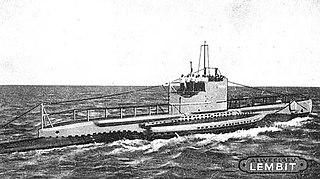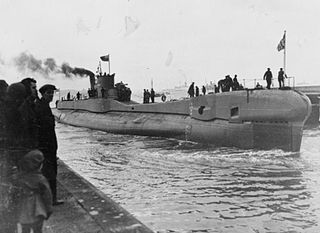
A submarine is a watercraft capable of independent operation underwater. It differs from a submersible, which has more limited underwater capability. It is also sometimes used historically or colloquially to refer to remotely operated vehicles and robots, as well as medium-sized or smaller vessels, such as the midget submarine and the wet sub. Submarines are referred to as "boats" rather than "ships" irrespective of their size.

An attack submarine or hunter-killer submarine is a submarine specifically designed for the purpose of attacking and sinking other submarines, surface combatants and merchant vessels. In the Soviet and Russian navies they were and are called "multi-purpose submarines". They are also used to protect friendly surface combatants and missile submarines. Some attack subs are also armed with cruise missiles mounted in vertical launch tubes, increasing the scope of their potential missions to include land targets.

The Finnish Navy is one of the branches of the Finnish Defence Forces. The navy employs 2,300 people and about 4,300 conscripts are trained each year. Finnish Navy vessels are given the ship prefix "FNS", short for "Finnish Navy ship", but this is not used in Finnish language contexts. The Finnish Navy also includes coastal forces and coastal artillery.
Vesikko is a submarine, which was launched on 10 May 1933 at the Crichton-Vulcan dock in Turku. Until 1936 it was named by its manufacturing codename CV 707. Vesikko was ordered by a Dutch engineering company Ingenieurskantoor voor Scheepsbouw in 1930 as a commercial submarine prototype. Purchased by the Finnish before the war, she saw service in the Winter War and World War II, sinking the Soviet merchant ship Vyborg as her only victory. After the cease-fire with the Allies in 1944, Vesikko was retired. Finland was banned from operating submarines after the war and she was kept in storage until she was turned into a museum ship.

The Tacoma class of patrol frigates served in the United States Navy during World War II and the Korean War. Originally classified as gunboats (PG), they were reclassified as patrol frigates (PF) on 15 April 1943. The class is named for its lead ship, Tacoma, a Maritime Commission (MARCOM) S2-S2-AQ1 design, which in turn was named for the city of Tacoma, Washington. Twenty-one ships were transferred to the British Royal Navy, in which they were known as Colony-class frigates, and twenty-eight ships were transferred under Lend-Lease to the Soviet Navy, where they were designated as storozhevoi korabl, during World War II. All Tacoma-class ships in US service during World War II were manned by United States Coast Guard crews. Tacoma-class ships were transferred to the United States Coast Guard and various navies post-World War II.

The Soviet Navy was the naval warfare uniform service branch of the Soviet Armed Forces. Often referred to as the Red Fleet, the Soviet Navy was a large part of the Soviet Union's strategic planning in the event of a conflict with the opposing superpower, the United States, during the cold war period between the two countries. The influence of the Soviet Navy played a large role in the events involving the Cold War (1945-1991), as the majority of conflicts centered with the American-led alliance in the Western Europe or power projection to maintain its sphere of influence in Eastern Europe.

The Barracuda-class submarines were the product of Project Kayo, a research and development effort begun immediately after World War II by the United States Navy to "solve the problem of using submarines to attack and destroy enemy submarines." They originally had the hull classification symbol SSK, for "hunter-killer submarine". It was known that the Soviet Navy had acquired the German Type XXI U-boat and other advanced submarines, and was expected to rapidly put derivatives of them into production. In 1948 the US Navy prepared estimates of the number of anti-submarine warfare (ASW)-capable submarines (SSKs) that would be needed to counter the hundreds of advanced Soviet submarines that were expected to be in service by 1960. Two scenarios were considered: a reasonable scenario assuming the Soviets would build to their existing force level of about 360 submarines, and a "nightmare" scenario projecting that the Soviets could build submarines as fast as the Germans had built U-boats, with a force level of 2,000 submarines. The projected US SSK force levels for these scenarios were 250 for the former and 970 for the latter. By comparison, the total US submarine force at the end of World War II, excluding obsolescent training submarines, was just over 200 boats.

A submarine chaser is a small and fast naval vessel that is specifically intended for anti-submarine warfare. Many of the American submarine chasers used in World War I found their way to Allied nations by way of Lend-Lease in World War II.

The Northern Fleet is the fleet of the Russian Navy in the Arctic.

The Baltic Fleet is the fleet of the Russian Navy in the Baltic Sea.

The RBU-6000Smerch-2 is a 213 mm caliber Soviet anti-submarine rocket launcher. It is similar in principle to the Royal Navy Hedgehog system used during the Second World War. The system entered service in 1960-61 and is fitted to a wide range of Russian surface vessels. It consists of a horseshoe shaped arrangement of twelve launch barrels, that are remotely directed by the Burya fire control system. It fires RGB-60 unguided depth charges. The rockets are normally fired in salvos of 1, 2, 4, 8 or 12 rounds. Reloading is automatic, with individual rounds being fed into the launcher by the 60UP loading system from a below deck magazine. Typical magazine capacity is either 72 or 96 rounds per launcher. It can also be used as a shore bombardment system.

The S-class or Srednyaya submarines were part of the Soviet Navy's underwater fleet during World War II. Unofficially nicknamed Stalinets, boats of this class were the most successful and achieved the most significant victories among all Soviet submarines. In all, they sank 82,770 gross register tons (GRT) of merchant shipping and seven warships, which accounts for about one-third of all tonnage sunk by Soviet submarines during the war.
The K class were the largest submarines built for the Soviet Navy in the World War II era.

EML Lembit is one of two Kalev-class mine-laying submarines built for the Republic of Estonia before World War II, and is now a museum ship in Tallinn. She was launched in 1936 at Vickers-Armstrongs, Barrow-in-Furness, and served in the Estonian Navy and the Soviet Navy. Until she was hauled out on 21 May 2011, Lembit was the oldest submarine still afloat in the world. Her sister ship, Kalev, was sunk in October 1941.

The MO is a class of small ships produced before and during World War II for the Soviet Navy. Their primary function originally was anti-submarine warfare. During the war they carried out many additional roles from supporting landing operations to escorting convoys. Over 350 ships were built.

The second HMS Mounsey (K569) was a British Captain-class frigate of the Royal Navy in commission during World War II. Originally constructed as the United States Navy Evarts-class destroyer escort DE-524, she served in the Royal Navy from 1943 to 1946.

S-56 was a Stalinets-class submarine of the Soviet Navy. She was laid down by shipyard #194 in Leningrad on 24 November 1936, shipped in sections by rail to Vladivostok where it was reassembled by Dalzavod. She was launched on 25 December 1939 and commissioned on 20 October 1941 in the Pacific Fleet. During World War II, the submarine was under the command of Captain Grigori Shchedrin and was moved from the Pacific Fleet to the Northern fleet across the Pacific and Atlantic Oceans via the Panama Canal. After decommissioning, the submarine was turned into a museum ship.
Soviet submarine K-51 was a K-class submarine of the Soviet Navy during World War II operating with the Baltic Fleet.

The Barents Sea campaign in 1941 was a submarine operation in the Arctic waters of the Barents Sea during World War II. It was a combined Soviet and British campaign, with boats departing from Polyarny to harass the German shipping lanes along the Norwegian coast.
















